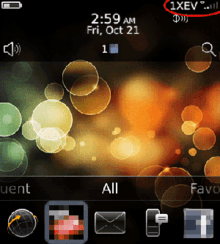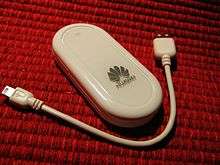CDMA2000
CDMA2000 (also known as C2K or IMT Multi‑Carrier (IMT‑MC)) is a family of 3G[1] mobile technology standards for sending voice, data, and signaling data between mobile phones and cell sites. It is developed by 3GPP2 as a backwards-compatible successor to second-generation cdmaOne (IS-95) set of standards and used especially in North America and South Korea.
CDMA2000 compares to UMTS, a competing set of 3G standards, which is developed by 3GPP and used in Europe, Japan, and China.
The name CDMA2000 denotes a family of standards that represent the successive, evolutionary stages of the underlying technology. These are:
- Voice: CDMA2000 1xRTT, 1X Advanced
- Data: CDMA2000 1xEV-DO (Evolution-Data Optimized): Release 0, Revision A, Revision B, Ultra Mobile Broadband (UMB)
All are approved radio interfaces for the ITU's IMT-2000. In the United States, CDMA2000 is a registered trademark of the Telecommunications Industry Association (TIA-USA).[2]
1X
CDMA2000 1X (IS-2000), also known as 1x and 1xRTT, is the core CDMA2000 wireless air interface standard. The designation "1x", meaning 1 times radio transmission technology, indicates the same radio frequency (RF) bandwidth as IS-95: a duplex pair of 1.25 MHz radio channels. 1xRTT almost doubles the capacity of IS-95 by adding 64 more traffic channels to the forward link, orthogonal to (in quadrature with) the original set of 64. The 1X standard supports packet data speeds of up to 153 kbit/s with real world data transmission averaging 80–100 kbit/s in most commercial applications.[3] IMT-2000 also made changes to the data link layer for greater use of data services, including medium and link access control protocols and QoS. The IS-95 data link layer only provided "best efforts delivery" for data and circuit switched channel for voice (i.e., a voice frame once every 20 ms).
1xEV-DO

CDMA2000 1xEV-DO (Evolution-Data Optimized), often abbreviated as EV-DO or EV, is a telecommunications standard for the wireless transmission of data through radio signals, typically for broadband Internet access. It uses multiplexing techniques including code division multiple access (CDMA) as well as time-division multiple access to maximize both individual user's throughput and the overall system throughput. It is standardized (IS-856) by 3rd Generation Partnership Project 2 (3GPP2) as part of the CDMA2000 family of standards and has been adopted by many mobile phone service providers around the world – particularly those previously employing CDMA networks.
1X Advanced
1X Advanced (Rev.E)[4][5] is the evolution of CDMA2000 1X. It provides up to four times the capacity and 70% more coverage compared to 1X.[6]
Networks
The CDMA Development Group states that, as of April 2014, there are 314 operators in 118 countries offering CDMA2000 1X and/or 1xEV-DO service.[7]
History
The intended 4G successor to CDMA2000 was UMB (Ultra Mobile Broadband); however, in November 2008, Qualcomm announced it was ending development of the technology, favoring LTE instead.[8]
References
- "What really is a Third Generation (3G) Mobile Technology" (PDF). International Telecommunications Union. Archived from the original (PDF) on June 7, 2011. Retrieved October 28, 2012.
- CDMA2000 trademark application, uspto.gov, November 17, 2009
- "CDG : Technology : CDMA2000 1X". CDMA Development Group. Retrieved July 28, 2017.
- "Evolution of CDMA Roadmap—Voice Perspective" (PDF). Alcatel-Lucent. May 13, 2010.
- "Guidelines for using cdma2000 1x Revision E Features on Earlier Revisions" (PDF). 3GPP2. July 2011. Archived from the original (PDF) on July 5, 2016. Retrieved May 17, 2016.
- "1X Advanced". Qualcomm. Retrieved September 18, 2013.
- "CDG : CDMA Statistics". CDMA Development Group. Retrieved June 13, 2015.
- Qualcomm halts UMB project, Reuters, November 13, 2008
External links
- TIA TR-45 Engineering Committee for CDMA Standards
- 3GPP2 Standards and specifications
- CDMA2000 Overviews of the CDMA2000 standards - 1X to UMB
- cdma2000.info Online interactive cdma2000 SDU decoder - covers all releases up to C.S0005-F 2.0
- A Detailed Introduction to the EV-DO Downlink
